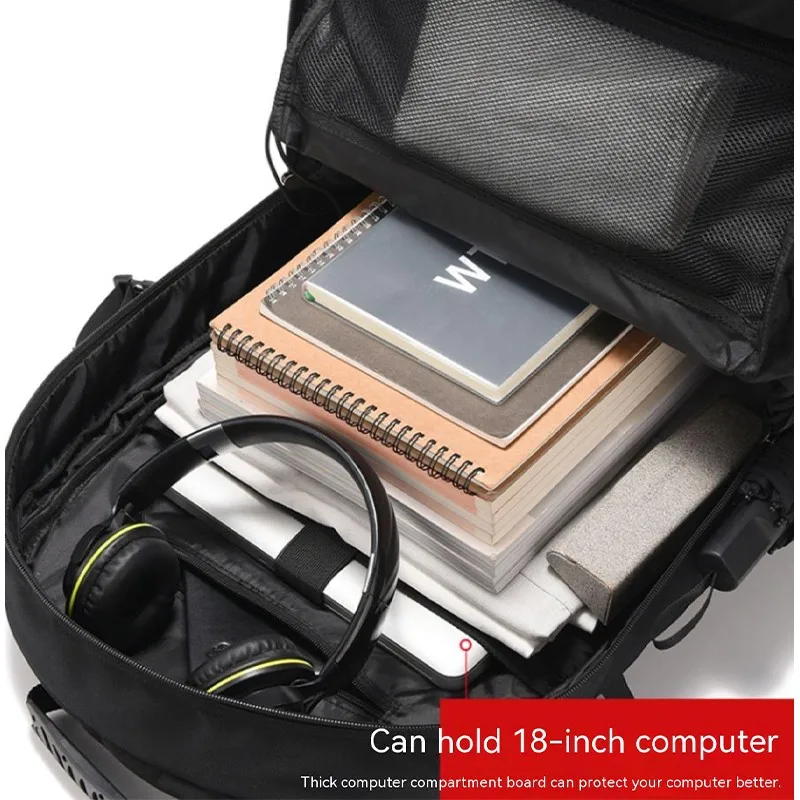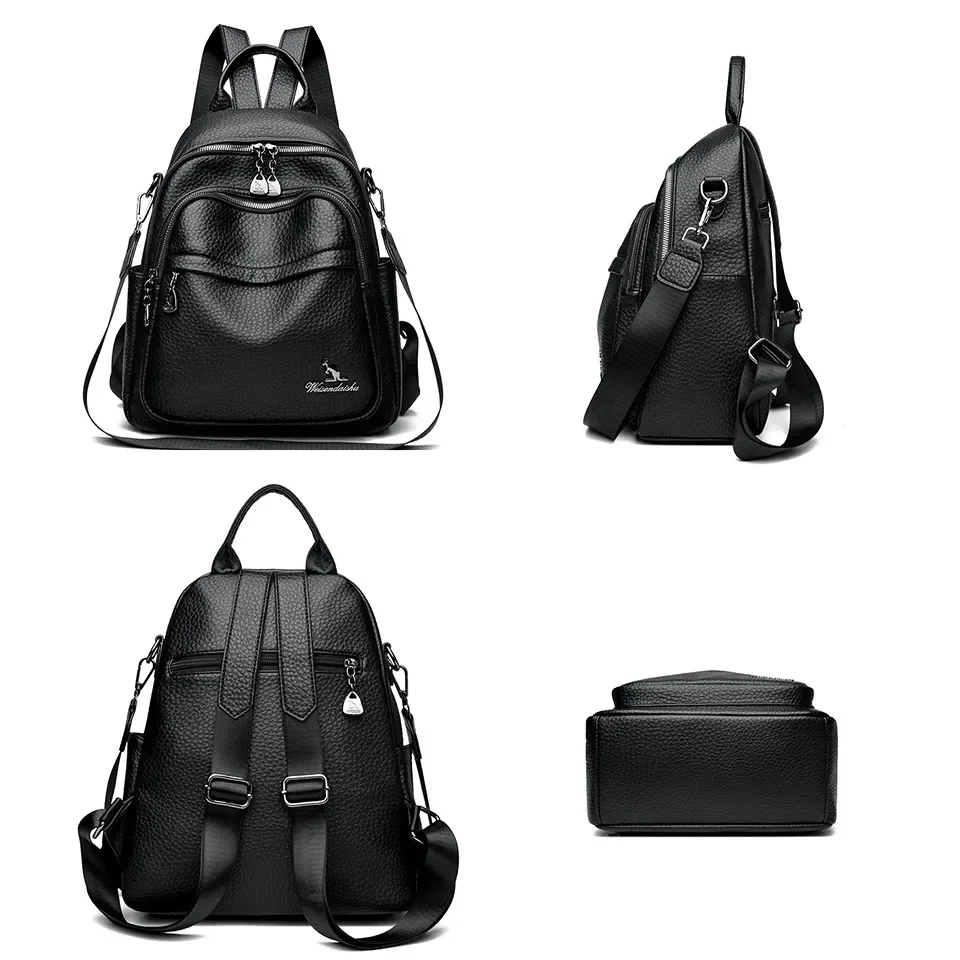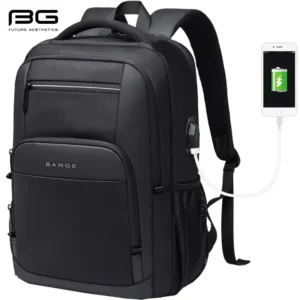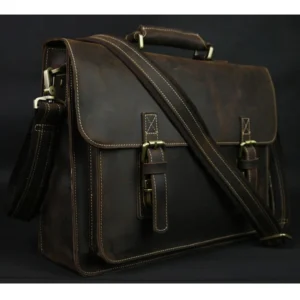The Perfect Academic Companion
College life demands a bag that can keep up with endless transitions between classes, study sessions, and social activities. Students face a unique challenge: finding a carrying solution that withstands heavy daily use while maintaining functionality and style. The constant transportation of laptops, textbooks, notebooks, and other essentials puts extraordinary strain on any bag, making material choice critically important.
Leather bags offer a compelling solution to this challenge. Their natural durability creates an academic companion that evolves alongside your education rather than deteriorating. Unlike synthetic alternatives that often show wear within months, quality leather develops character over time, actually improving in appearance throughout your academic career.
What sets student-friendly leather bags apart is their thoughtful combination of durability, organization, comfort, and professional appearance. These bags strike a delicate balance – providing ample space for academic necessities while maintaining a silhouette that transitions seamlessly from lecture halls to internship offices.
While the initial investment in a quality leather bag might seem substantial compared to synthetic options, the long-term value proposition becomes clear when considered over the span of an academic career. Fashionable leather backpacks for students offer both practical functionality and timeless style that extends far beyond graduation day.
Why Leather Stands Above Other Materials for Student Life
When selecting a bag for academic life, material quality directly impacts your daily experience and long-term satisfaction. Leather offers several distinct advantages that make it particularly well-suited for the student lifestyle:
Exceptional Longevity: While synthetic bags might last 1-2 years of heavy student use, quality leather bags can easily survive your entire academic career and beyond, often lasting a decade or more with proper care.
Progressive Improvement: Unlike synthetic materials that degrade over time, leather develops a rich patina that enhances its character and appearance through years of use—your bag effectively tells the story of your academic journey.
Superior Protection: Leather’s natural density and shock absorption properties provide significantly better protection for expensive electronics and academic materials than thinner synthetic alternatives.
Professional Versatility: A quality leather bag transitions seamlessly from casual classroom settings to professional environments, making it appropriate for internships, job interviews, and eventual career settings—eliminating the need for multiple bags.
Environmental Considerations: Though the initial production impact is higher, the extended lifespan of quality leather products results in less overall waste compared to disposable synthetic bags that require frequent replacement.
The differences between leather and canvas student bags become apparent after just months of daily use. While canvas may initially seem more casual and appropriate for campus life, its faster deterioration at stress points like straps and corners creates a false economy.
The investment in a well-made leather bag pays dividends through years of reliable service. Understanding what constitutes quality construction is essential when evaluating durable leather backpacks for daily use. The initial cost difference becomes negligible when amortized over the product’s much longer functional lifespan.
Essential Capacity Features for Academic Success
The internal organization of a student leather bag directly impacts your daily efficiency. Strategic compartmentalization transforms a simple carrying solution into a mobile organizational system that protects your essentials while ensuring quick access between classes.
Key capacity features to seek in student-friendly leather bags include:
Dedicated Laptop Compartment: Look for padded compartments that accommodate laptops up to 15.6 inches (the most common student laptop size) while providing sufficient padding on all sides, including the bottom.
Textbook-Friendly Main Compartment: The primary storage area should easily accommodate several large textbooks plus notebooks without straining seams or zippers. A width of at least 12 inches and depth of 4-5 inches ensures adequate capacity.
Strategic Organization: Effective student bags balance simplicity with functionality through thoughtfully placed interior pockets for small essentials (pens, calculators, chargers) without creating an overly complicated system that slows access.
External Quick-Access Pockets: Secure but easily accessible external pockets for items needed between classes (phone, ID card, transit pass) prevent the need to open the main compartment repeatedly.
The design of leather school bags with laptop compartments reflects an understanding of modern academic needs, where electronic devices require both protection and accessibility. The best designs maintain slim profiles even when fully loaded, preventing the bag from becoming unwieldy during busy campus navigation.
For maximum versatility, explore the range of leather laptop backpacks that combine academic functionality with everyday practicality. These designs recognize that student life doesn’t pause between classes but extends to libraries, coffee shops, and study groups—all requiring different organizational needs.
Ergonomic Designs for All-Day Comfort
The physical strain of carrying academic materials throughout long campus days makes comfort features non-negotiable in student leather bags. Proper ergonomics prevent the development of back and shoulder issues that can impact both academic performance and quality of life.
Essential comfort elements to evaluate include:
Strategic Weight Distribution: Properly designed bags distribute weight across the strongest parts of your body rather than concentrating pressure on shoulders or lower back. Backpack styles typically offer the most balanced distribution for heavy loads.
Strap Padding and Width: Look for straps at least 2 inches wide with dense foam padding that won’t compress and lose effectiveness over time. This prevents the straps from digging into shoulders even when carrying maximum loads.
Back Panel Design: Structured back panels with strategic padding provide lumbar support while allowing airflow to prevent overheating and discomfort during extended wear.
Multiple Carry Options: Reinforced handles positioned at the bag’s center of gravity provide alternative carrying methods for short distances, reducing strain during transitions between classes.

The benefits of compartmentalized leather bags extend beyond organization to directly impact comfort. Properly distributed contents maintain the bag’s center of gravity close to your body, reducing strain and improving posture while navigating busy campus environments.
Weight distribution remains one of the most overlooked factors in student bag selection. Even the most beautiful and well-organized bag becomes impractical if its design creates physical discomfort that discourages daily use.
Construction Quality: The Foundation of Durability
The durability of a leather student bag directly correlates with its construction quality. Understanding key quality indicators helps distinguish between bags that merely look premium and those that will actually perform throughout your academic career.
Critical construction elements include:
Leather Grade: Full-grain leather, derived from the top layer of the hide with intact natural grain, offers superior durability and develops the richest patina over time. Top-grain leather (the second-highest quality) provides good durability with less weight and cost. “Genuine leather” typically indicates lower-quality processed leather that won’t offer comparable longevity.
Hardware Quality: Zippers, buckles, and rivets experience constant stress and become common failure points in lower-quality bags. Look for recognized hardware brands like YKK zippers and solid metal (rather than plated plastic) fixtures that won’t crack under pressure.
Stitching Pattern: Double stitching at stress points indicates thoughtful construction designed for longevity. The stitching should be tight, even, and without loose threads, ideally reinforced at corners and strap attachments.
Edge Treatment: Properly finished and sealed edges prevent fraying and extend the leather’s lifespan. Quality bags feature burnished or painted edges rather than raw, exposed leather at trim points.
Water Resistance: While natural leather isn’t completely waterproof, quality bags incorporate water-resistant treatments or waxed finishes that provide reasonable protection against light rain without compromising the leather’s breathability.
Exploring full-grain leather backpack options reveals the substantial difference in durability between premium and budget leather products. The higher initial investment in quality construction directly translates to extended functional lifespan, particularly under the demanding conditions of student life.
The Investment Perspective: Cost vs. Long-Term Value
Evaluating leather bags through an investment lens changes the conversation from immediate price to long-term economics. Quality leather bags represent a different purchasing paradigm—one focused on acquiring fewer, better items that deliver extended service rather than requiring frequent replacement.
Consider these economic perspectives:
Cost Per Use Calculation: A $200 leather bag used daily for five years costs approximately $0.11 per use. Meanwhile, a $50 synthetic bag replaced yearly for five years costs about $0.14 per use—making the premium option actually more economical over time.
Depreciation Difference: Unlike synthetic bags that have little to no resale value after use, quality leather bags maintain significant value and can often be resold if your needs change, recovering a portion of your initial investment.
Strategic Budget Allocation: Rather than compromising on overall quality, consider prioritizing essential features (laptop protection, comfort, capacity) while accepting simplification in non-critical areas (excessive pockets, decorative elements).
Timing Advantages: Shopping during off-season sales or academic year transitions often yields significant discounts on premium leather bags, making quality more accessible to student budgets.
The true value of durable leather bags for daily classes becomes apparent through the absence of disruption—no midterm emergencies with broken straps, no damaged electronics from inadequate padding, and no need for annual replacements. This reliability creates both economic and practical advantages throughout your academic journey.
Leather Bag Styles Optimized for Student Life
Different academic programs, commuting patterns, and personal preferences call for varied leather bag styles. Understanding the strengths of each design helps match your selection to your specific student lifestyle.
Backpack Designs
- Optimal for heavy loads and extensive campus walking
- Even weight distribution reduces physical strain
- Leaves hands free for doors, coffee cups, or phone use
- Most accommodating for larger textbooks and materials
- Often features dedicated laptop protection against back
Messenger Bags
- Facilitates quick access to contents without removing the bag
- Streamlined profile navigates crowded transit and hallways easily
- Professional appearance suitable for internships and presentations
- Typically lighter than backpacks when carrying moderate loads
- Side-body positioning provides awareness of contents during travel
Convertible Designs
- Transforms between backpack and messenger/briefcase styles
- Adapts to changing daily needs and environments
- Eliminates the need for multiple bags for different settings
- Particularly valuable for students balancing academics with professional roles

The growing popularity of stylish leather backpacks for college reflects the modern student’s need for functional accessories that complement rather than compromise their personal style. Contemporary designs recognize that academic practicality and aesthetic appeal aren’t mutually exclusive.
For students whose daily activities vary significantly, convertible leather backpack options provide adaptability without sacrificing quality. These versatile designs transition between professional and casual environments, accommodating the fluid nature of student schedules.
Security Features for Protecting Academic Essentials
Campus environments and public transportation present unique security challenges for students carrying valuable electronics and personal items. Thoughtful security features protect both your physical belongings and digital information.
Critical security elements include:
Closure Systems: Full-length zippers with overlapping flaps prevent items from falling out during transit and create barriers against opportunistic theft. Magnetic closures offer convenience but typically provide less security than mechanical systems.
Strategic Pocket Placement: Hidden pockets positioned against your back or under flaps secure high-value items (wallet, phone) while remaining accessible. Avoid designs with external pockets positioned behind you where they become invisible to you but accessible to others.
Anti-Theft Features: Slash-resistant materials and reinforced attachment points prevent quick-cut theft attempts. Some designs incorporate locking zippers or cable-securing systems for library or coffee shop study sessions.
RFID Blocking Pockets: Protected compartments for student IDs, credit cards, and electronic door access cards prevent electronic scanning and unauthorized data collection, particularly important in dense campus environments.
Understanding different types of closures in leather backpacks helps identify the right balance between security and accessibility for your specific campus environment. Urban campuses typically warrant stronger security features than smaller rural schools.
Maintaining Your Leather Bag Throughout Your Academic Career
The longevity of a leather bag directly correlates with proper maintenance. Fortunately, basic leather care can be integrated into even the busiest student schedule without requiring significant time investment.
Essential maintenance practices include:
Daily Attention: Simple habits like emptying your bag completely once weekly prevents buildup of debris that can abrade the leather from within. Wiping with a dry cloth removes surface dust before it becomes embedded.
Weather Protection: Apply a quality leather conditioner once per semester to maintain moisture balance and prevent drying or cracking. Water-repellent sprays create additional protection during rainy seasons without compromising leather breathability.
Stress Prevention: Avoid overpacking beyond the bag’s designed capacity, which strains seams and accelerates wear. Rotate heavy items between different sections to distribute stress evenly.
Storage Considerations: During academic breaks, stuff the bag with acid-free tissue to maintain its shape, apply conditioner before storage, and keep it in a dust bag away from direct sunlight or heating elements.
Spill Response: Address liquid spills by blotting (never rubbing) with an absorbent cloth, then allowing natural drying away from direct heat sources. For ink marks, consult a leather professional rather than attempting home remedies that might set the stain.
Proper maintenance ensures your leather backpack remains functional and attractive throughout your entire academic program and beyond. The minimal time investment yields significant returns through extended product lifespan and maintained appearance.
Finding Your Perfect Match: Decision Framework
With numerous options available, finding the ideal leather bag for your specific academic needs requires systematic evaluation rather than impulse purchasing. Consider this structured approach:
Assess Your Daily Load: Inventory everything you carry on your heaviest day (laptop, books, supplies, personal items). This establishes your minimum capacity requirement and prevents selecting an inadequate bag.
Analyze Your Movement Patterns: Consider your typical day—walking distances between classes, time spent standing on public transit, frequency of transitions between buildings. Longer walking distances generally favor backpack styles for comfort.
Evaluate Environmental Factors: Consider weather conditions at your campus, time spent outdoors between buildings, and typical transportation methods. Wetter climates warrant additional weather protection features.
Define Your Style Parameters: While functionality remains primary, selecting a bag that complements your personal style ensures you’ll actually use it consistently rather than leaving it aside for something more aesthetically pleasing but less practical.
Establish Your Investment Timeline: Determine whether you need this bag to last through a specific degree program or serve you into early career years. Longer timelines justify higher initial investment in premium construction.

Finding the perfect leather backpack for campus means identifying the intersection of practicality, durability, comfort, and personal preference. The ideal bag becomes an unnoticed companion that simplifies rather than complicates your academic experience.
14 Inch Leather Laptop Backpack, Brown Leather Backpack, Men's Leather Backpack, Vintage Leather Backpack
Price range: $177.28 through $199.12 Select options This product has multiple variants. The options may be chosen on the product pageCarry On Leather Backpack, Roll Top Leather Backpack
Price range: $77.76 through $96.48 Select options This product has multiple variants. The options may be chosen on the product pageDesigner Men's Backpack, Men's Leather Laptop Backpack, Men's Leather Work Backpack
Price range: $158.04 through $160.04 Select options This product has multiple variants. The options may be chosen on the product pageDesigner Mini Backpack, Mini Leather Backpack, Small Leather Sling Backpack, Women's Leather Backpack
Price range: $95.76 through $98.80 Select options This product has multiple variants. The options may be chosen on the product pageDesigner Mini Backpack, Designer Women's Backpack, Mini Leather Backpack, Women's Leather Backpack
Price range: $135.92 through $137.64 Select options This product has multiple variants. The options may be chosen on the product page15 Inch Leather Laptop Backpack, Leather Briefcase Backpack
$332.96 Select options This product has multiple variants. The options may be chosen on the product page
Frequently Asked Questions About Student Leather Bags
Aren’t leather bags too heavy for students carrying already heavy books?
Modern leather bag design has evolved significantly, with many student-friendly options incorporating lightweight construction techniques. While leather is inherently heavier than some synthetics, the difference is typically 8-16 ounces—negligible when distributed properly across the body. The superior organization in quality leather bags often results in better weight distribution that actually feels lighter during extended wear.
How much maintenance do leather bags really require?
Basic leather maintenance is surprisingly simple. For student life, a seasonal application of leather conditioner (taking about 15 minutes) and occasional water-repellent spray during rainy periods provides adequate care. Daily maintenance requires nothing more than emptying the bag regularly and avoiding extended exposure to harsh direct sunlight.
Can leather bags really survive coffee spills and campus food accidents?
Quality leather is remarkably resilient to common campus accidents. Quick blotting of spills prevents most staining, and many modern leather bags feature interior linings that protect the leather from internal spills. Unlike fabric bags that absorb and retain odors, leather can be wiped clean of most substances without retaining smells.
Are leather bags appropriate for casual campus environments?
Contemporary leather bag designs span a wide aesthetic spectrum, from formal briefcases to casual distressed leather backpacks. Many student-focused designs intentionally create a relaxed appearance that fits perfectly in casual campus settings while maintaining the material’s inherent durability advantages.
Developing effective systems for organizing textbooks in leather backpacks helps maximize both the bag’s capacity and your efficiency between classes. Strategic organization transforms even moderately-sized bags into highly functional academic tools.
Balancing Practicality and Style: The Summit Carry Approach
Summit Carry designs each leather backpack with the understanding that student life demands both unwavering functionality and personal expression. Our development process focuses on creating bags that serve as reliable tools rather than mere accessories, incorporating feedback from actual students across diverse academic programs.
We select full-grain leather specifically for its unmatched durability and natural ability to withstand the rigors of daily campus use. Our hardware undergoes extensive testing to ensure it withstands thousands of open/close cycles—simulating years of between-class transitions.
Our organizational systems reflect actual student carrying patterns, with dedicated protection for electronic devices alongside thoughtfully designed spaces for textbooks, notebooks, and daily essentials. The interior color contrasts in women’s leather laptop backpacks and other designs facilitate quick visual identification of contents during busy class transitions.
Each Summit Carry bag is designed to develop character throughout your academic journey, with leather that patinas beautifully through years of faithful service. Unlike disposable alternatives, these bags become personal artifacts that tell the story of your educational path—from freshman orientation through graduation and beyond.






